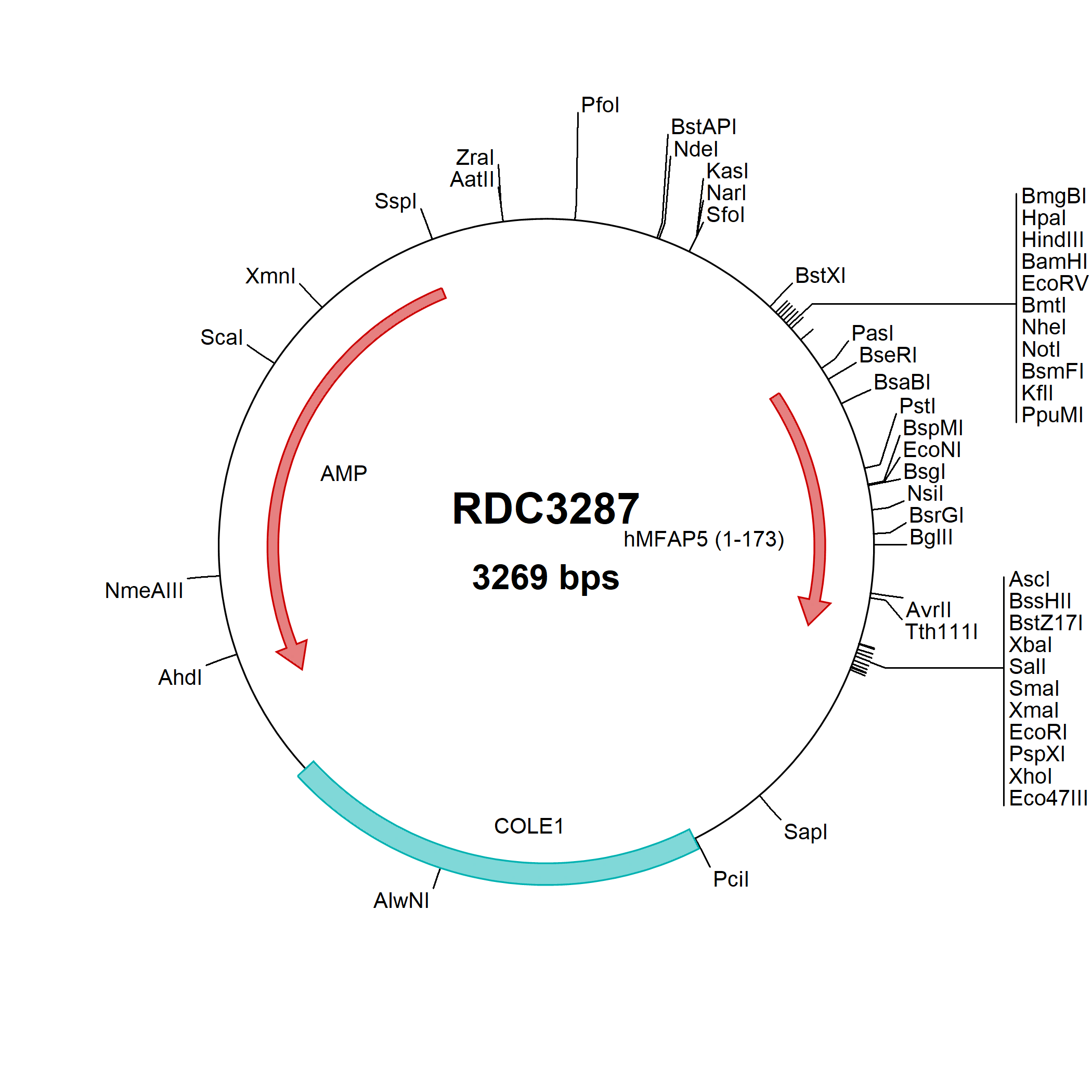MAGP-2/MFAP5 Products
MAGP-2 (Microfibril-associated glycoprotein 2), also called MFAP5 (microfibril associated protein 5) is a secreted, cell-associated 25 kDa mammalian member of the MFAP family of proteins. Human MAGP-2 cDNA encodes 173 amino acids (aa) including a 21 aa signal sequence, an RDG motif (aa 30-32; absent in MAGP-1) and a central cysteine-rich binding domain (aa 84-140). One potential splice variant shows a 10 aa deletion between aa 73-82 that includes the only potential glycosylation site. Mature human MAGP-2 shares 80%, 82%, 82%, 84% and 85% aa identity with mouse, rat, bovine, porcine and canine MAGP-2, respectively. Both MAGP-1 and MAGP-2 bind and covalently crosslink fibrillins 1 and 2 through the binding domain, but MAGP-2 has more limited distribution and binds a more limited set of extracellular matrix proteins. However, the MAGP-2 RGD motif binds to the integrin alpha v beta 3, allowing cell attachment to microfibrils. MAGP-2 is thought to facilitate microfibril assembly and induce elastin fiber formation. Through its binding to EGF repeats, MAGP-2 mediates the metalloproteinase-dependent release of Jagged1 and the metalloproteinase-independent release of Notch extracellular domains. In endothelial cells, MAGP-2 promotes angiogenic sprouting through inhibiting Notch signaling, binding integrin alpha v beta3 (which then enhances VEGF signaling), and/or enhancing endothelial cell response to FGF basic and EGF. In ovarian cancer, MAGP-2 expression is associated with cancer cell survival, increased microvessel density, and poor prognosis. Skin MAGP-2 expression is increased in human scleroderma and the tight skin (TSK) mouse; MAGP-2 may contribute to abnormal collagen accumulation in these conditions by increasing the half-life of type I collagen. Fibrillin-1 mutations within the region that binds MAGP-2 can be found in Marfan syndrome.
36 results for "MAGP-2/MFAP5" in Products
36 results for "MAGP-2/MFAP5" in Products
MAGP-2/MFAP5 Products
MAGP-2 (Microfibril-associated glycoprotein 2), also called MFAP5 (microfibril associated protein 5) is a secreted, cell-associated 25 kDa mammalian member of the MFAP family of proteins. Human MAGP-2 cDNA encodes 173 amino acids (aa) including a 21 aa signal sequence, an RDG motif (aa 30-32; absent in MAGP-1) and a central cysteine-rich binding domain (aa 84-140). One potential splice variant shows a 10 aa deletion between aa 73-82 that includes the only potential glycosylation site. Mature human MAGP-2 shares 80%, 82%, 82%, 84% and 85% aa identity with mouse, rat, bovine, porcine and canine MAGP-2, respectively. Both MAGP-1 and MAGP-2 bind and covalently crosslink fibrillins 1 and 2 through the binding domain, but MAGP-2 has more limited distribution and binds a more limited set of extracellular matrix proteins. However, the MAGP-2 RGD motif binds to the integrin alpha v beta 3, allowing cell attachment to microfibrils. MAGP-2 is thought to facilitate microfibril assembly and induce elastin fiber formation. Through its binding to EGF repeats, MAGP-2 mediates the metalloproteinase-dependent release of Jagged1 and the metalloproteinase-independent release of Notch extracellular domains. In endothelial cells, MAGP-2 promotes angiogenic sprouting through inhibiting Notch signaling, binding integrin alpha v beta3 (which then enhances VEGF signaling), and/or enhancing endothelial cell response to FGF basic and EGF. In ovarian cancer, MAGP-2 expression is associated with cancer cell survival, increased microvessel density, and poor prognosis. Skin MAGP-2 expression is increased in human scleroderma and the tight skin (TSK) mouse; MAGP-2 may contribute to abnormal collagen accumulation in these conditions by increasing the half-life of type I collagen. Fibrillin-1 mutations within the region that binds MAGP-2 can be found in Marfan syndrome.
| Source: | NS0 |
| Accession #: | Q13361 |
| Applications: | BA |
| Source: | CHO |
| Accession #: | AAH25131 |
| Applications: | BA |
| Reactivity: | Human |
| Details: | Sheep IgG Polyclonal |
| Applications: | WB |
| Reactivity: | Human |
| Details: | Rabbit IgG Polyclonal |
| Applications: | IHC, WB |
| Reactivity: | Human |
| Details: | Sheep IgG Polyclonal |
| Applications: | WB |
| Applications: | AC |
| Reactivity: | Human |
| Details: | Mouse IgG Polyclonal |
| Applications: | WB |
| Reactivity: | Human |
| Details: | Rabbit IgG Polyclonal |
| Applications: | ELISA |
| Reactivity: | Human |
| Details: | Rabbit IgG Polyclonal |
| Applications: | ELISA |
| Reactivity: | Human |
| Details: | Rabbit IgG Polyclonal |
| Applications: | ELISA |
| Reactivity: | Human |
| Details: | Rabbit IgG Polyclonal |
| Applications: | ELISA |
| Reactivity: | Human |
| Details: | Rabbit IgG Polyclonal |
| Applications: | ELISA |
| Reactivity: | Human |
| Details: | Rabbit IgG Polyclonal |
| Applications: | ELISA |
| Reactivity: | Human |
| Details: | Rabbit IgG Polyclonal |
| Applications: | ELISA |
| Reactivity: | Human |
| Details: | Rabbit IgG Polyclonal |
| Applications: | ELISA |
| Reactivity: | Human |
| Details: | Rabbit IgG Polyclonal |
| Applications: | ELISA |
| Reactivity: | Human |
| Details: | Rabbit IgG Polyclonal |
| Applications: | ELISA |
| Reactivity: | Human |
| Details: | Rabbit IgG Polyclonal |
| Applications: | ELISA |
| Reactivity: | Human |
| Details: | Rabbit IgG Polyclonal |
| Applications: | ELISA |
| Reactivity: | Human |
| Details: | Rabbit IgG Polyclonal |
| Applications: | ELISA |
| Reactivity: | Human |
| Details: | Rabbit IgG Polyclonal |
| Applications: | ELISA |
| Reactivity: | Human |
| Details: | Rabbit IgG Polyclonal |
| Applications: | ELISA |
| Reactivity: | Human |
| Details: | Rabbit IgG Polyclonal |
| Applications: | ELISA |
| Reactivity: | Human |
| Details: | Rabbit IgG Polyclonal |
| Applications: | ELISA |



![Immunohistochemistry-Paraffin: MAGP-2/MFAP5 Antibody [NBP1-82803] Immunohistochemistry-Paraffin: MAGP-2/MFAP5 Antibody [NBP1-82803]](https://resources.bio-techne.com/images/products/MAGP-2-MFAP5-Antibody-Immunohistochemistry-Paraffin-NBP1-82803-img0007.jpg)

![Western Blot: MAGP-2/MFAP5 Antibody [H00008076-B01P] Western Blot: MAGP-2/MFAP5 Antibody [H00008076-B01P]](https://resources.bio-techne.com/images/products/MAGP-2-MFAP5-Antibody-Western-Blot-H00008076-B01P-img0003.jpg)
